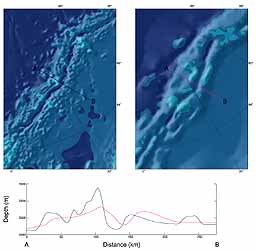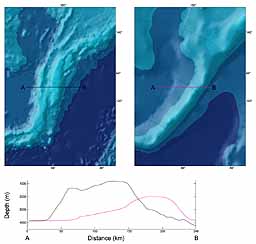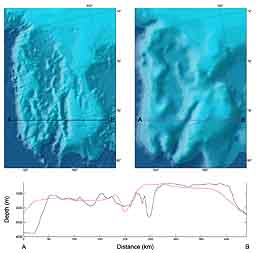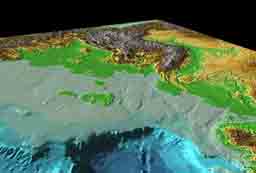|
Introduction
For over two decades Sheet 5.17 of the General Bathymetric Chart of the Oceans
(GEBCO, Canadian Hydrographic Service, 1979) served as an authoritative portrayal of
the seafloor north of 64°N. While this contour map provided a general description of
major features of the seabed, evidence was accreting to indicate that many of the smaller
and scientifically significant features were poorly or wrongly defined.
The International Bathymetric Chart of the Arctic Ocean (IBCAO) was developed from
an accumulation of bathymetric measurements collected during past and modern
expeditions. The undertaking has produced a 2.5 x 2.5 km grid and derivative maps
(Jakobsson et al., 2000) that represent a considerable improvement over previous
descriptions of the morphology of the Arctic seabed. The most substantial improvement
is in the central Arctic Ocean, where a nearly empty database was significantly enriched
by the addition of historic and modern observations collected by US and British
submarines (DeLaca and Gossett, 1996; Showstack, 1997), by Swedish and German
icebreakers, and by depths derived from a new contour map prepared by the Russian
Navy (Head Department of Navigation and Hydrography et al., 1999). The database for
the shallow shelves of the Laptev and East Siberian Seas has been enhanced as well,
absorbing a large quantity of depth values that were extracted from a suite of small scale
navigational charts issued by the Russian Navy.
This note provides examples of the above improvements by contrasting the GEBCO and
IBCAO representations of the seafloor in four regions of the Arctic Ocean: the Gakkel
Ridge, the Lomonosov Ridge, the Chukchi Borderland, and the continental shelves of the
Chukchi, Eastern Siberian and Laptev Seas. These regions are shown on the cover page.
The GEBCO information that was used in this comparison was actually taken from a
digital rendition of GEBCO Sheet 5.17, constructed from bathymetric contours that were
distributed on CD-ROM as part of the GEBCO Digital Atlas (Jones et al., 1994). The
contours were used to develop a Cartesian depth grid (5 x 5 km grid cells) on a polar
stereographic map projection with the true scale at 75°N (Geological Survey of Canada,
1994). These map parameters are consistent with the original paper map, and they are
also compatible with those of the new IBCAO map. Both the GEBCO and the IBCAO
grids were created by means of the GMT program surface (Smith and Wessel, 1990). The
comparisons that follow consist of side-by-side shaded relief portrayals of three study
areas, constructed from the GEBCO and IBCAO grids using identical illumination
parameters and color tables (Figure 1).

Figure 1. The color table used to create the shaded relief maps in figures 2-5.
The Gakkel Ridge
The Gakkel Ridge is a spreading ridge that separates the Nansen and Amundsen Basins.
It is a continuation of the mid-oceanic ridge system into the Arctic Ocean (e.g., Johnson
and Heezen, 1967; Vogt, 1986).
The GEBCO map portrays the western end of the Gakkel Ridge with a smooth and highly
generalized morphology (Figure 2). On the IBCAO map, the Ridge flanks feature a
blocky configuration, while the Ridge's axial valley is continuous, more pronounced, and
deeper, reaching depths below 5000 m and containing several interaxial highs.

Figure 2. A comparison of the Gakkel Ridge, portrayed by IBCAO (left) and GEBCO (right).
The Lomonosov Ridge
Measuring about 1700 km in length, the Lomonosov Ridge is considered to be of
continental origin, a sliver that was separated from the Kara and Barents shelves and
transported to its present position by sea-floor spreading (e.g., Sweeney et al., 1982;
Kristoffersen, 1990).
On the GEBCO map, the Lomonosov Ridge is a continuous feature that extends from the
continental shelf off Ellesmere Island towards the North Pole, where it changes direction
slightly and continues along the 140°E meridian to the continental shelf off the New
Siberian Islands. The most striking discrepancies between the GEBCO and IBCAO
portrayals occur between the North Pole and the Siberian continental shelf (Figure 3).
The new model shows a far more complex morphology, with a ridge that is broken into
several smaller segments, and a pronounced kink that projects into Amundsen Basin.
Moreover, the crest is generally shallower, wider, and notably flattopped at several
sections.

Figure 3. A comparison of the Lomonosov Ridge inthe vicinity of the North Pole,
portrayed by IBCAO (left) and GEBCO (right).
The Chukchi Borderland
Measuring about 600 by 700 km, the Chukchi Borderland extends from the continental
shelves of Eastern Siberia and Western Alaska into the deep Amerasian Basin. It contains
three north-south trending structures: Northwind Ridge, Chukchi Cap and Arlis Plateau -
the last feature is commonly considered to be a part of the Mendeleev Ridge. Adjacent to
these ridge-like structures lie the Northwind, Chukchi and Mendeleev Abyssal Plains.
GEBCO and IBCAO comparisons are limited here to the Northwind Ridge and the
Chukchi Cap. Both are among the more extensively mapped features in the Arctic Ocean,
see e.g. the compilation map published by the US Naval Research Laboratory (Perry et
al., 1985).

Figure 4. A comparison of the Northwind Ridge and the Chukchi Cap in the Chukchi Borderland,
portrayed by IBCAO (left) and GEBCO (right).
On the IBCAO map, these features appear to be more highly segmented than on previous
maps, and their surfaces display irregularities that suggest complex sea-floor processes
(Figure 4).
The continental shelves of the Eastern Siberian and Laptev Seas
The shelf areas of the Eastern Siberian and Laptev Seas are shallow, generally less than
50 m deep, with a very flat relief.
With a 50 m minimum depth contour, the GEBCO map reveals very little bathymetric
information over these huge shelf areas. On the other hand, a shaded relief
implementation of the IBCAO map is effective at portraying depth variations of only tens
of metres, accentuating the shallow paleo-river valleys that incise these areas, along with
low-relief erosional and depositional features (Figure 5).

Figure 5. Oblique view of the continental shelves of the Eastern Siberian and Laptev
Seas. The coloration of shallow regions is not the same as in Figures 1-4 on account of
a different shading technique that was applied to emphasize low-relief features.
Bibliography
Canadian Hydrographic Service. General Bathymetric Chart of the Oceans (GEBCO)
Sheet 5.17; map 1:6,000,000. Canadian Hydrographic Service, Ottawa, 1979.
DeLaca, T., and J. Gossett. Nuclear Submarines and Oceanography in the Arctic;
Witness the Arctic: Chronicles of the Arctic System Science Research Program, Arctic
Research Consortium of the United States, Spring 1996, Vol. 3, No. 1., 1996.
Geological Survey of Canada. Bathymetric and topographic shaded relief north of 64N;
polar stereographic projection, variable scale, distributed in hardcopy or digital form.
GSC Open File 2900, Geological Survey of Canada, Dartmouth NS, 1994.
Head Department of Navigation and Oceanography, All-Russia Research Institute for
Geology and Mineral Resources of the World Ocean, and Russian Academy of Sciences.
Bottom relief of the Arctic Ocean; map 1:5 Million. Head Department of Navigation and
Oceanography, St. Petersburg, 1999.
Jakobsson, M., N.Z. Cherkis, J. Woodward, R. Macnab, and B. Coakley. New grid of
Arctic bathymetry aids scientists and mapmakers; Eos, Transactions, American
Geophysical Union, in press.
Jones, M.T., A.R. Tabor, and P. Weatherall. GEBCO Digital Atlas: CDROM and
supporting Volume. British Oceanographic Data Centre, Birkenhead, UK., 1994.
Johnson, G. L., and Heezen, B. C. The Arctic Mid-Oceanic Ridge; Nature, vol. 215, pp.
724-725, 1967.
Kristoffersen, Y. Eurasia Basin; In: A. Grantz, L. Johnson, and F.J. Sweeney (Eds.), The
Arctic Ocean Region; DNAG, vol. L: pp. 365-378, 1990.
Perry, R.K., H.S. Fleming, J.R. Weber, Y. Kristofferson, J.K. Hall, A. Grantz, G.L.
Johnson. Bathymetry of the Arctic Ocean; map 1:4,704,075. Naval Research Laboratory,
Washington, 1985.
Showstack, R., Navy to Release Storehouse of Arctic Ocean Data. EOS, Trans. Amer.
Geophys. Un. vol. 78, no. 35, pp. 370-371, 1997.
Smith, W. H. F., and P. Wessel, Gridding with continuous curvature splines in tension,
Geophysics, vol. 55, pp. 293-305, 1990.
Sweeney, J. F., R. R. Weber, , and S. M. Blasco. Continental ridges in the Arctic Ocean:
LOREX constraints; Tectonophysics, v. 89, p. 217-238, 1982.
United States Arctic Research Commission. US Arctic Research Commission and US
Navy Announce Release of Arctic Ocean Bathymetry Data; Press Release, August 21,
1997, US Arctic Research Commission, Arlington VA, USA.
Vogt, P. R. Geophysical and geochemical signatures and plate tectonics; In: The Nordic
Seas, Hurdle, B. G. (ed.), Springer-Verlag, pp. 413-662, 1986.
 Return to Arctic Bathymetry Page Return to Arctic Bathymetry Page
|

![]()